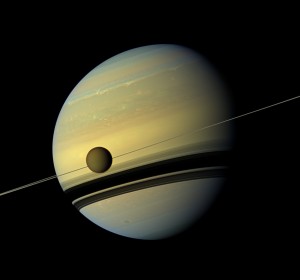
Titan’s atmosphere makes Saturn’s largest moon look like a fuzzy orange ball in this natural-color view from the Cassini spacecraft. Cassini captured this image in 2012. Image Credit: NASA/JPL-Caltech/Space Science Institute
How hard to get a tantalizing whiff of Titan?
Data from the NASA Cassini spacecraft’s Composite Infrared Spectrometer has been used to simulate Titan’s chemistry. A research team has been able to classify a previously unidentified material discovered by the Cassini spacecraft in the moon’s smoggy haze.
Titan’s dirty orange color comes from a mixture of hydrocarbons (molecules that contain hydrogen and carbon) and nitrogen-carrying chemicals called nitriles.
Nosey scientists began with benzene, which has been identified in Titan’s atmosphere, followed by a series of closely related chemicals that are likely to be present there. All of these gases belong to the subfamily of hydrocarbons known as aromatics.
Basic recipe
The outcome is that scientists chose an aromatic that contained nitrogen. When team members analyzed those lab products, they detected spectral features that matched up well with the distinctive signature that had been extracted from the Cassini-collected Titan data.
“Now we can say that this material has a strong aromatic character, which helps us understand more about the complex mixture of molecules that makes up Titan’s haze,” said Melissa Trainer, a planetary scientist at NASA’s Goddard Space Flight Center in Greenbelt, Maryland.
Carrie Anderson, a Cassini participating scientist at Goddard, was a co-author on the study, along with Trainer, Mark Loeffler and Joshua Sebreea, lead author of the study.
Now that the basic recipe has been demonstrated, future work will concentrate on tweaking the experimental conditions to perfect it.
The laboratory experiments were funded by NASA’s Planetary Atmospheres program.
The research is available online in the scientific journal Icarus at:
http://www.sciencedirect.com/science/article/pii/S0019103514001651
By Leonard David
